Pennhurst Asylum: The Shame of Pennsylvania
This state-funded school and hospital center was at the heart of the human rights movement that revolutionized this country’s approach to healthcare for the mentally and physically handicapped. This facility was one of the most striking examples of the maltreatment that was characteristic of such institutions––at one point, papers labeled it “The Shame of the Pennsylvania”. And the legacy of all this suffering might just be the lingering spirits that are said to still wander its abandoned wards today.
The History and Horror of Pennhurst Asylum
By Matt Lake, Rusty Tagliareni and Mark Moran
Back in the mid 1960s, fledgling TV reporter Bill Baldini ran a five-episode exposé of Pennhurst State School and Hospital on Philadelphia’s TV10 (now an NBC affiliate). It painted a picture of neglect and abuse in the Chester County institution that was hard for the regular viewers to stomach. On the flickering monochrome televisions of the time came images of full-grown hands and feet bound by straps to adult-sized crib beds. Inmates of the institution were shown rocking, pacing, and twitching. Many were severely disabled either mentally or physically, but others were quite lucid and coherent—but withdrawn into themselves because of over-stimulation of the senses in the loud and sometimes frightening place, and a lack of much-needed mental stimulation. The five-minute news segments were entitled “Suffer the Little Children.” When one patient was asked by the interviewer what he would like most in the world, if he could have anything he wanted, the sad and withdrawn reply was simply, “To get out of Pennhurst.”
This state-funded school and hospital center was at the heart of the human rights movement that revolutionized this country’s approach to healthcare for the mentally and physically handicapped. This facility was one of the most striking examples of the 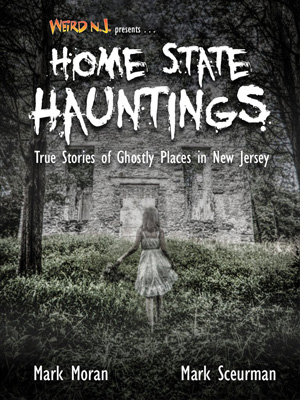 maltreatment that was characteristic of such institutions––at one point, papers labeled it “The Shame of the Pennsylvania”.
maltreatment that was characteristic of such institutions––at one point, papers labeled it “The Shame of the Pennsylvania”.
Pennhurst first opened its doors in November of 1908, and due to pressure to accept not only the mentally and physically handicapped, but also immigrants, criminals and orphans who could not be housed elsewhere, it was overcrowded within only a few years. In 1913, the Commission for the Care of the Feeble-Minded was appointed, and boldly stated that those with disabilities were “unfit for citizenship” and furthermore, “posed a menace to the peace.” Patients at Pennhurst were grouped into several general categories. Under the classification of mental prowess, one was listed as either an “imbecile” or “insane”. Physically, the patient could be declared either “epileptic” or “healthy”.
Like many similar facilities of the era, Pennhurst was functioned almost completely independently from the rest of society. It operated its own power plant, policed its own grounds and produced its own food. Any additional needs were supplied by a railway line that connected the campus to the outside world. The facility could operate without any interaction with the surrounding community, and that was the way the community preferred it.
By the mid-1960s, Pennhurst had been open for fifty years. It housed 2,791 people, most of them children, which was about 900 more than the administration thought the buildings could comfortably accommodate. But as a state school, they had to take what they were given. Only 200 of the residents were in any kind of art, education, or recreation programs that would help to improve their condition, though many of the patients were high-functioning enough to improve with the right care. The administrators interviewed in this program recognized that they were falling short of their ideal treatment, but with a crumbling building, a budget shortfall of four million dollars, and only 9 medical doctors and 11 teachers (none of them with special education training), their hands were tied.
Probably the most chilling scene in the 30 minutes of documentary footage in the TV10 report showed one of the hospital’s physicians describing how he dealt with a particularly vicious bully who had brutalized one of his other inmates. He described how he had asked one of his colleagues which injection he could use to cause the most discomfort to a patient without permanently injuring him. Then he proceeded to administer that injection to the bully.
From that point on, it was inevitable that the hospital would close down, but it took two decades of legal actions, federal judgments made and overturned, and growing financial crises for the place to be shuttered. By the 1980’s, overcrowding, lack of funds, inadequate staffing and decades of abuse and neglect accusations caught up with the operation, and in 1987 Pennhurst closed its doors. Its death was not without positive impact, though. The martyrdom of its long suffering patients helped put into motion changes to medical practice across the country and to society as a whole.
Despite the ultimate outcome, many former residents and staff members maintain that Pennhurst served some of its inmates very well. Some high-functioning patients received the treatment and therapies they needed to prepare themselves for living in the outside world. And some patients were so mentally handicapped that they injured themselves at the slightest provocation. One patient would charge into the walls headfirst. Such patients probably needed to be restrained for their own protection.
When Pennhurst closed, it suffered fewer invasions than some other abandoned Pennsylvania hospitals, due in part to the presence of a National Guard post and Veteran’s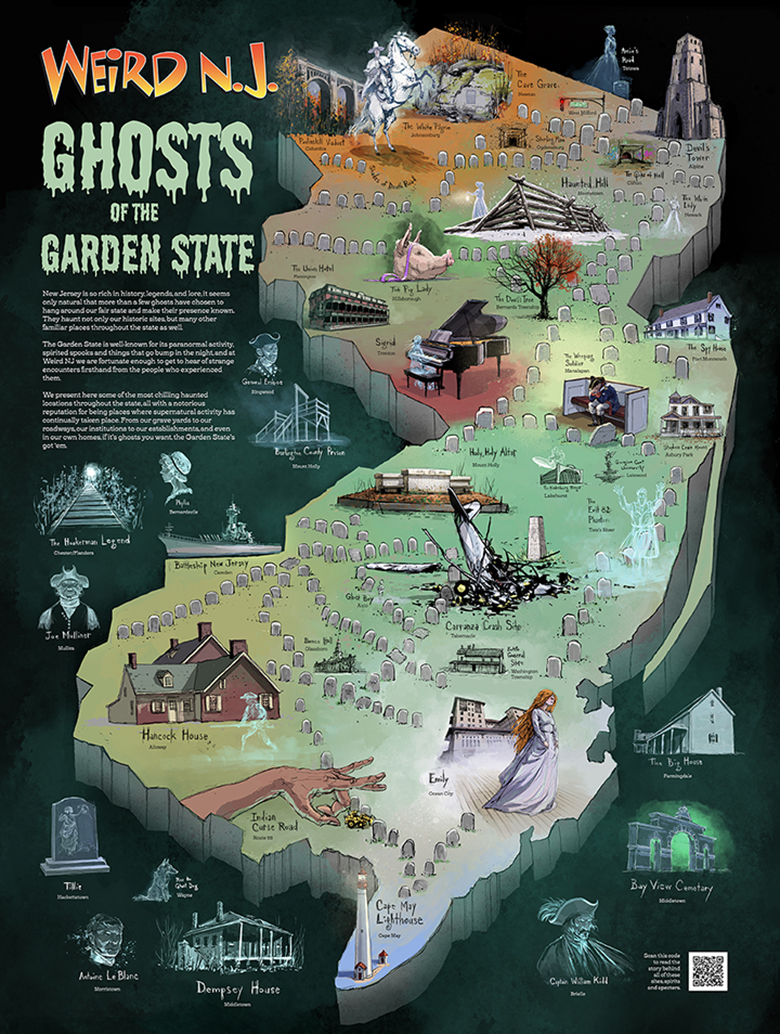 Hospital on part of the property at that time. Today the place is in the hands of private owners, and at the center of an unusual controversy. One of the modern functions is as a haunted house attraction (www.pennhurstasylum.com), a use that has generated concern among those who view it as deeply disrespectful to those who suffered the brutality that once took place here. The present owners are taking steps to reverse the 23 years of damage wrought by time and vandalism to the remaining buildings. They were kind enough to allow Weird NJ on the property to document this interesting transition. They gave us a guided tour of many of the buildings, including some that needed to be unsealing for us to gain entry.
Hospital on part of the property at that time. Today the place is in the hands of private owners, and at the center of an unusual controversy. One of the modern functions is as a haunted house attraction (www.pennhurstasylum.com), a use that has generated concern among those who view it as deeply disrespectful to those who suffered the brutality that once took place here. The present owners are taking steps to reverse the 23 years of damage wrought by time and vandalism to the remaining buildings. They were kind enough to allow Weird NJ on the property to document this interesting transition. They gave us a guided tour of many of the buildings, including some that needed to be unsealing for us to gain entry.
Timothy Smith, the son of the facility’s owner, who took the time to speak with Weird NJ, expressed a desire to restore the better portion of the property, with the eventual goal of creating a museum and historical tour open to the public. We’d like to think that in such a way, the place could finally serve some good purpose, educating the public in the errors of previous generations and commemorating all the lives that were spent here.
Paranormal Pennhurst
Naturally, as with any such institution with a sorted history of human suffering, violence and death, Pennhurst is not without its share of ghostly tales. Pennhurst is allegedly so haunted, in fact, that its paranormal presences have spawned a spectral cottage industry––ghost hunting on the grounds of the old asylum. In addition to overseeing the restoration projects at Pennhurst and operating the Pennhurst Asylum haunted attraction during the Halloween season, Timothy Smith is also President and CEO of the Pennhurst Paranormal Association. Using the enticing tagline, “They lived here, died here and are still here,” the organization plans to open up the former hospital to the public for ghost hunts on the campus. With other former institutions-turned-tourist-attractions such as Eastern State Penitentiary in Philadelphia and Waverly Hills Sanatorium in Louisville, Kentucky as a business models, Timothy believes that the public’s curiosity about Pennhurst’s spooks make it a potentially very profitable paranormal property. The television show “Ghost Adventures” has already filmed an episode of their Travel Channel program here.
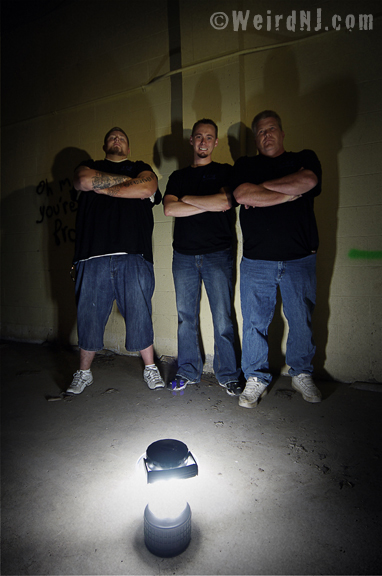
During Weird NJ’s tour of Pennhurst we were joined by members of the Shore Paranormal Research Society (S.P.R.S.) who have become the official paranormal investigators for the former institution. The S.P.R.S. is an Ocean County, NJ based team of trained individuals whose sole purpose is to find the truth behind claims of paranormal activity. According to Jim Ansbach, the group’s founder and case manager, Pennhurst is rife with such activity. The group has conducted several large-scale investigations of the old asylum’s many buildings, and documented a variety of evidence of paranormal activity––including photos, videos, recordings of voice phenomena and personal encounters with spirits. Among the recordings are the sounds of disembodies voices uttering things like “go away”, “I’ll kill you”, “we’re upset”, and “why’d you come here?” An unknown male states, “I’m scared” while an invisible female asks, “why won’t you leave?”
Here are just some of the group’s other findings:
Quaker Building: Numerous shadows manifest and dissipate at will. These shadows include what appeared to be a small female child with long black hair, a hunched over presence with long dangling arms and the upper portion of bodies looking over or around 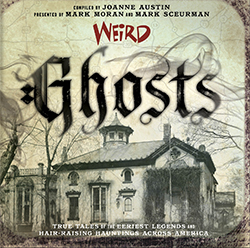 obstacles. Doors and a rocking chair have moved without anyone being near them. Investigator was shoved from behind hard enough on a stairway to leave a deep red mark on the small of back. Investigator was scratched on the arm by unknown object when they were not by anything or close to any walls. Objects being propelled in the basement such as a pry bar, some sort of brass fixture, and various other unknown objects. Multiple EVP’s (electronic voice phenomena) as well EMF spikes throughout the building when there is no electric supplied to any building there. Our Psychic Medium, Sharon Pugh, has felt multiple energies there including either a demonic force or a past life that wasn’t a very nice person.
obstacles. Doors and a rocking chair have moved without anyone being near them. Investigator was shoved from behind hard enough on a stairway to leave a deep red mark on the small of back. Investigator was scratched on the arm by unknown object when they were not by anything or close to any walls. Objects being propelled in the basement such as a pry bar, some sort of brass fixture, and various other unknown objects. Multiple EVP’s (electronic voice phenomena) as well EMF spikes throughout the building when there is no electric supplied to any building there. Our Psychic Medium, Sharon Pugh, has felt multiple energies there including either a demonic force or a past life that wasn’t a very nice person.
Limerick Building: The apparition of a woman in a old style nurse’s uniform was observed by a fire fighter, police officer and a marine. Multiple EVP’s.
Devon Building: Unknown sounds and multiple EVP’s.
Mayflower Building: Shadow people seen multiple times. EVP’s captured. Investigators have been touched in this building.
Tinicum Building: Multiple EVP’s. Investigator had their legs touched.
Philadelphia Building: Loud sounds and voices heard coming from the building. Investigators surrounded the building and entered it via the tunnel system. No one was in the building nor could they have fled without being observed.
Administration Building: Multiple voices heard at various times and EVP’s caught of what appears to be a toilet flushing. This building has no running water or bathroom fixtures.
Hershey Building: Investigator heard a female child’s voice on the third floor.
For a full report of all the S.P.R.S.’s investigations and gathered evidence visit their web site at: ShoreParanormal.com
Those interested in participating in a Pennhurst ghost hunt can find more information by visiting the web site PennhurstParanormal.com

The Children Did Suffer
Lots of medical professionals I work with did a stint at Pennhurst early in their careers. It was a boarding school as well as a hospital, though the more low-functioning residents were incapable of speaking, let alone learning anything, and many of the high-functioning residents never learned to read. Most of the people there weren’t insane, just mentally retarded, autistic or suffering other serious physical impairments. Some residents apparently just had learning disabilities or hyperactivity and emotional problems that made them seem more impaired. They would end up on high-functioning wards
Photo by Rusty Tagliareni
My colleagues told me that the staff would put the high-functioning residents who acted out to work in low-functioning wards as a punishment. They even called the low-functioning wards “punishment wards.” Many of those kids who acted out weren’t bad kids; they were often victims of bullies. The nasty kids would attack the other residents with broom handles and do much worse. Some cases of deaths that were attributed to suicide or accident were probably extreme cases of bullying. Naturally, the bullies would seldom get caught, so when their victims acted out, they were the ones who had to slop up after the severely handicapped residents. But Pennhurst wasn’t a bad organization in itself. It just suffered the problems that many institutions do, and so its residents suffered too. –MelB
Photo by Rusty Tagliareni
The Pennhurst Family Album
When I went to Pennhurst at night, it scared me halfway to death. When the wind blows across the buildings, it sounds like someone walking. There were dead animals there, and what looked like blood on some of the equipment. Once is enough. I’m never going back. But there was this one room that was really interesting. It was strewn with papers and photographs, carpeted with them, wall-to-wall. I didn’t read the papers, but the black-and-white photographs looked like something from a family album. –Anonymous
For more on this story and all the other strange sites that the Quaker State has to offer, check out our book Weird Pennsylvania.
Pennhurst Video by Antiquity Echoes.
The preceding article is an excerpt from Weird NJ magazine, “Your Travel Guide to New Jersey’s Local Legends and Best Kept Secrets,” which is available on newsstands throughout the state and on the web at www.WeirdNJ.com. All contents ©Weird NJ and may not be reproduced by any means without permission.
Visit our SHOP for all of your Weird NJ needs: Magazines, Books, Posters, Shirts, Patches, Stickers, Magnets, Air Fresheners. Show the world your Jersey pride some of our Jersey-centric goodies!
Now you can have all of your favorite Weird NJ icons on all kinds of cool new Weird Wear, Men’s Wear, Women’s Wear, Kids, Tee Shirts, Sweatshirts, Long Sleeve Tees, Hoodies, Tanks Tops, Tie Dyes, Hats, Mugs & Backpacks! All are available in all sizes and a variety of colors. Visit WEIRD NJ MERCH CENTRAL. Represent New Jersey!
![]()

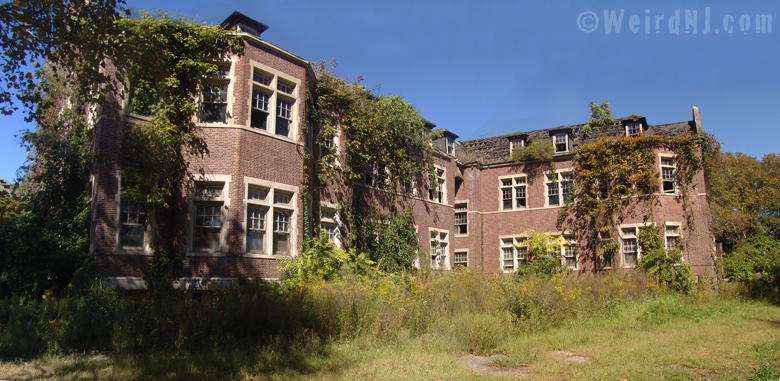
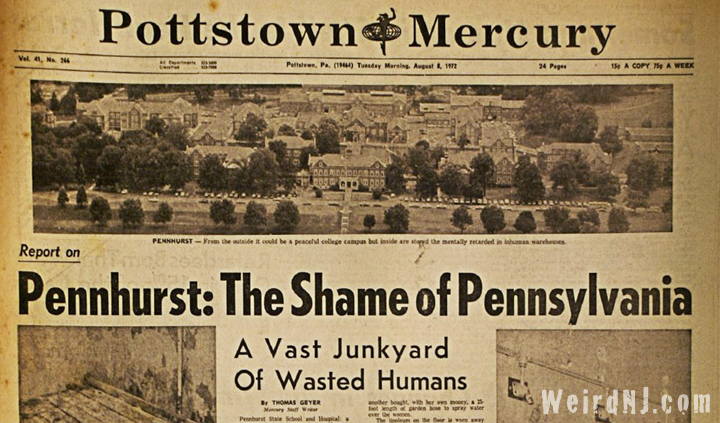
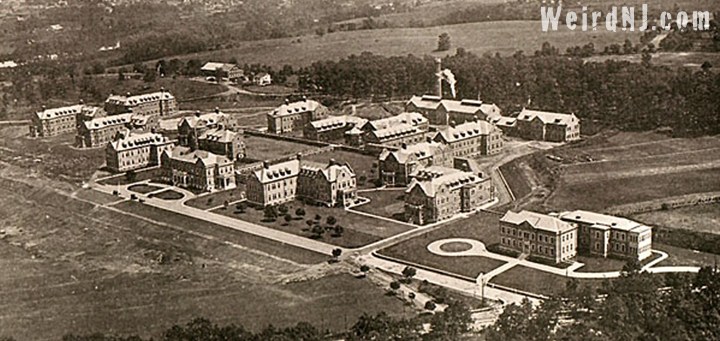
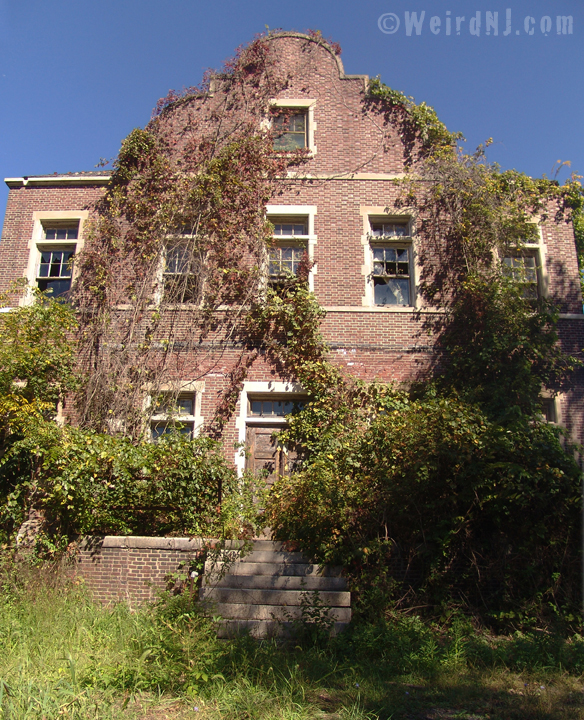
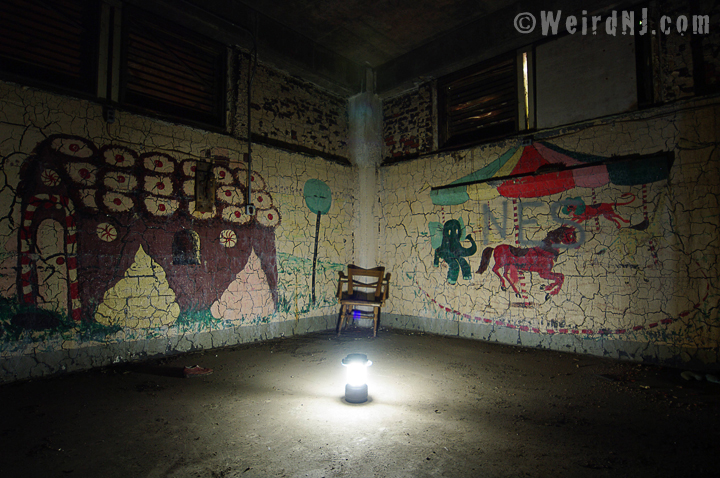



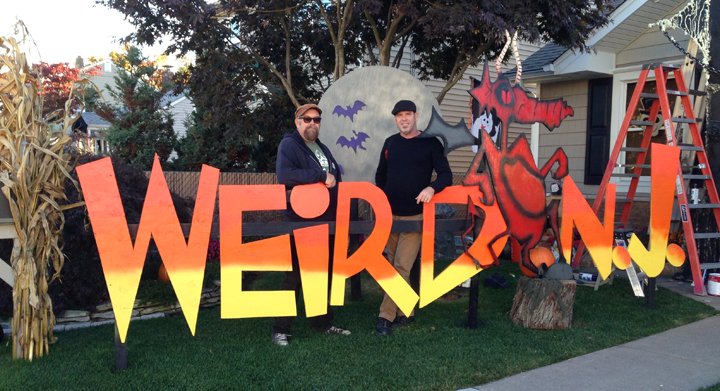
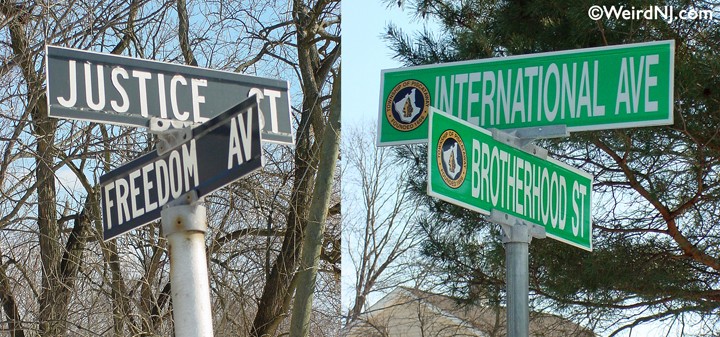
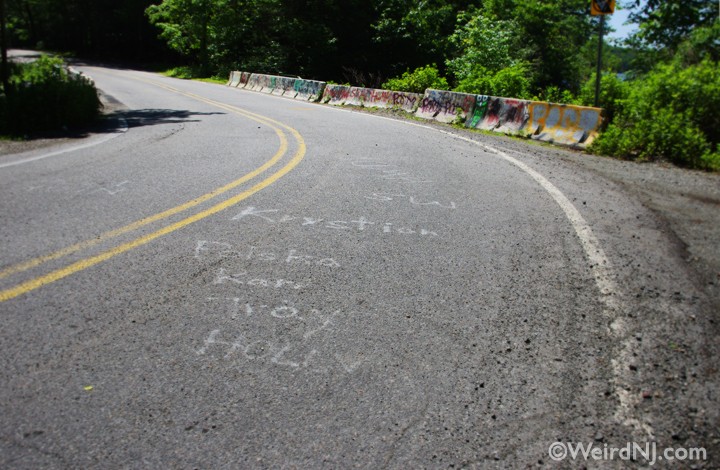

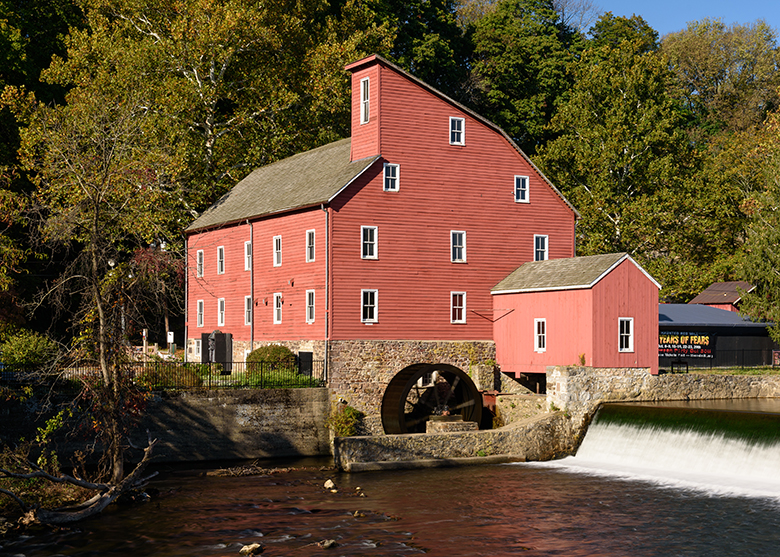


1 thought on “Pennhurst Asylum: The Shame of Pennsylvania”